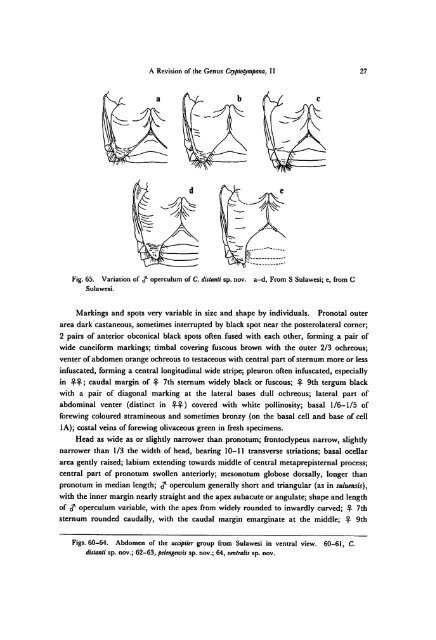A Revision of the Genus Cryptotympana (Homoptera, Cicadidae)
A Revision of the Genus Cryptotympana (Homoptera, Cicadidae)
A Revision of the Genus Cryptotympana (Homoptera, Cicadidae)
You also want an ePaper? Increase the reach of your titles
YUMPU automatically turns print PDFs into web optimized ePapers that Google loves.
A <strong>Revision</strong> <strong>of</strong> <strong>the</strong> <strong>Genus</strong> <strong>Cryptotympana</strong>, II27Fig. 65. Variation <strong>of</strong> f operculum <strong>of</strong> C. distanti sp. nov. a-d, From S Sulawesi; e, from CSulawesi.Markings and spots very variable in size and shape by individuals. Pronotal outerarea dark castaneous, sometimes interrupted by black spot near <strong>the</strong> posterolateral corner;2 pairs <strong>of</strong> anterior obconical black spots <strong>of</strong>ten fused with each o<strong>the</strong>r, forming a pair <strong>of</strong>wide cuneiform markings; timbal covering fuscous brown with <strong>the</strong> outer 2/3 ochreous;venter <strong>of</strong> abdomen orange ochreous to testaceous with central part <strong>of</strong> sternum more or lessinfuscated, forming a central longitudinal wide stripe; pleuron <strong>of</strong>ten infuscated, especiallyin -°-°-; caudal margin <strong>of</strong> •?- 7th sternum widely black or fuscous; -°- 9th tergum blackwith a pair <strong>of</strong> diagonal marking at <strong>the</strong> lateral bases dull ochreous; lateral part <strong>of</strong>abdominal venter (distinct in •?••£) covered with white pollinosity; basal 1/6-1/5 <strong>of</strong>forewing coloured stramineous and sometimes bronzy (on <strong>the</strong> basal cell and base <strong>of</strong> cell1A); costal veins <strong>of</strong> forewing olivaceous green in fresh specimens.Head as wide as or slightly narrower than pronotum; frontoclypeus narrow, slightlynarrower than 1/3 <strong>the</strong> width <strong>of</strong> head, bearing 10-11 transverse striations; basal ocellararea gently raised; labium extending towards middle <strong>of</strong> central metaprepisternal process;central part <strong>of</strong> pronotum swollen anteriorly; mesonotum globose dorsally, longer thanpronotum in median length; f operculum generallyshort and triangular (as in suluensis),with <strong>the</strong> inner margin nearly straight and <strong>the</strong> apex subacute or angulate; shape and length<strong>of</strong> f operculum variable, with <strong>the</strong> apex from widely rounded to inwardly curved; $- 7thsternum rounded caudally, with <strong>the</strong> caudal margin emarginate at <strong>the</strong> middle; •£ 9thFigs. 60-64. Abdomen <strong>of</strong> <strong>the</strong> accipiter group from Sulawesi in ventral view. 60-61, C.distanti sp. nov.; 62-63, pelengensis sp. nov.; 64, centralis sp. nov.
















